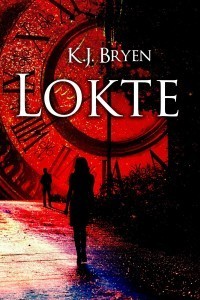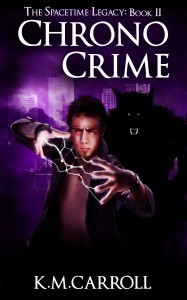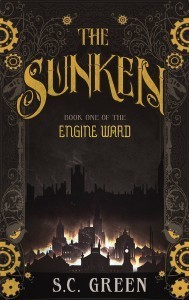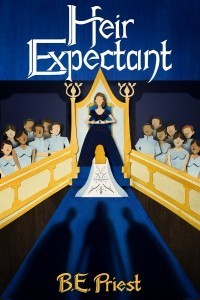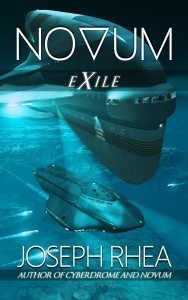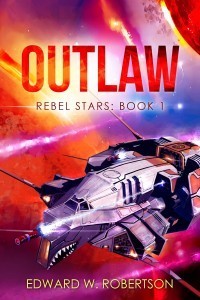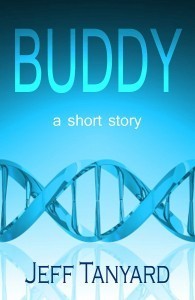Cora Buhlert's Blog, page 114
September 29, 2014
Indie Speculative Fiction of the Month: September 2014
 It’s that time of the month again, time for “Indie Speculative Fiction of the Month”.
It’s that time of the month again, time for “Indie Speculative Fiction of the Month”.
So what is “Indie Speculative Fiction of the Month”? It’s a round-up of speculative fiction by indie authors newly published this month, though some August books I missed the last time around snuck in as well. The books are arranged in alphabetical order by author. So far, most links only go to Amazon.com, though I may add other retailers for future editions.
Once again, we have a broad spectrum of titles, featuring hard science fiction, space opera, Steampunk, dystopian fiction, post-apocalyptic fiction, epic fantasy, urban fantasy, Wuxia fantasy, Arabian Nights retellings, demons, werewolves, vampires, shape-shifting dragons, superheroes, immortals and much more.
Don’t forget that Indie Speculative Fiction of the Month is also crossposted to the Speculative Fiction Showcase, a group blog run by Heidi Garrett, Jessica Rydill and myself, which features new release spotlights, guest posts, interviews and link round-ups regarding all things speculative fiction several times per week.
As always, I know the authors at least vaguely, but I haven’t read all of the books, so Caveat emptor.
And now on to the books without further ado:
In this harrowing companion novel to Ellisa Barr’s book, Outage, the devastating effects of an EMP attack are experienced all over again, only this time the story unfolds on a cruise ship far out to sea.
Sena Morgan has just begun the voyage of a lifetime, but she’ll never reach her destination. A terrorist-launched EMP destroys the ship’s power and communication systems and starts a fire onboard, leaving thousands of passengers stranded in the cold, northern Pacific.
As food and water dwindle, strangers with a deadly secret are brought aboard the ship. Sena’s only hope of survival is to get as far from them as possible. At sea, there’s nowhere to run.
Sena meets a couple trying to get home to their daughter in a small town in Washington. Together they will face unspeakable challenges as they try to reunite with their families despite a terrifying new reality.
Written for all fans that love apocalypse stories, Voyage is a Young Adult survival novel that mixes an action packed story with themes of family, hope, and determination.
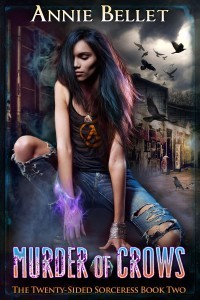 Murder of Crows by Annie Bellet
Murder of Crows by Annie Bellet
They say you can never go home again. If only that were true…
Game store owner and nerd sorceress extraordinaire Jade Crow knows death stalks her in the form of her murderous ex-lover, Samir, a sorcerer who wants to eat her heart and take her power. With the help of her friends, and sexy tiger-shifter Alek, Jade trains for the inevitable confrontation.
Until her estranged father shows up begging for help. Someone or something is murdering the crow shifters of Three Feathers ranch and her father believes sorcery is the only way to stop the killings.
Faced with an unknown foe, a family that exiled her decades before, a deepening relationship with Alek, and Samir’s ever-present threat, Jade will need all the power she’s gained and then some to stop the Murder of Crows.
Murder of Crows is the second book in The Twenty-Sided Sorceress urban fantasy series, following Justice Calling.
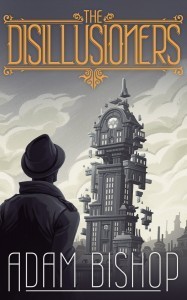 The Disillusioners by Adam Bishop
The Disillusioners by Adam Bishop
Jarvis is an investigative journalist with a penchant for making ill-advised sarcastic remarks to powerful government officials. He works for a small, rebel newspaper called The Disillusioners whose approach to tackling the news is explained in their motto: “Dispelling the Illusions of power.” A large amount of money from the government’s budget has mysteriously gone missing, and Jarvis is trying to figure out why. But the Hammers – the aristocrats who control Cirilia’s government – are determined to make sure the story never comes out.
A political mystery set against the backdrop of a magically-powered industrial revolution, The Disillusioners chronicles the economic upheaval sweeping across Cirilia. Small, family-owned businesses struggle to keep up with the ruthless efficiency of the magicorporations. The old order is overthrown as money, not magic, becomes the dominant form of social control. And a few powerful men believe the changes are a signal that progress must be brought to every corner of the globe, by force if necessary.
As Jarvis races to uncover the fate of the missing money, he will confront the role that magic has played in determining who has power and how they get to wield it. He will be challenged to figure out where the line is drawn between luck and intention. And he must fight to reveal his government’s secrets and hope that in the absence of power, truth is enough.
Marianne Garcia is a struggling actress in New York City. With a dead career and her mother dying of cancer, she begins to lose faith in a better life.
That is, until Logan Lokte shows up.
The mysterious Logan offers her everything she has dreamed of, promising that he can not only make her a famous actress, but can stop the cancer spreading in her mother’s body. All Marianne has to do is sign a contract.
Marianne doesn’t believe in magic, and she has lost all faith in miracles. So why does she find herself strangely drawn to him? Who is Logan Lokte? And if she were to sign the contract . . . what would the consequences be?
In this tale of passion, murder, and deceit, Marianne’s decision thrusts them both into a spiral where choices are crucial, and evil comes from within.
But they also must learn that, in life, not every door is locked.
Indal, chronomancer and werewolf, has been in exile for six months, and survived everything the desert could throw at him.
Now he has to survive multi-world gangsters.
His friends, Carda and Michelle, drag him home and present him with Michelle’s corpse–sent back in time from the near future. But Indal’s efforts to check out the timeline reveals that the corpse is a killer construct, out to murder them all.
While trying to discover who sent it, Indal stumbles into a crime ring of smugglers, blind alchemists, magic-stealing elves, and breakdancing gravity mages. They want him and his friends dead.
Because plans are in motion to that will shake the entire multiverse. And only Indal and his friends can stop them.
This is book 2 in the Spacetime Legacy series, following Storm Chase.
I have always disagreed with his following into my father’s footsteps and becoming a mindguard. I said to him, ”Son, the mind can be a very powerful enemy.” He never listened, though. I remember his answer was always, ”It might be your enemy, father – he never called me dad – it might be your enemy, but it isn’t mine!”
– Robert Ayers, father of suspect Sheldon Ayers – Enforcement Unit Archives, File number 986697714, Investigation of Ayers-Ross Thought-Protection Agency on one count of treason against the IFCO, with intention to overthrow the Council of Presidents.
In a future world where telepathy has left the human mind exposed and mindcrimes are a constant threat to information and privacy, powerful telepaths specialize in protecting their clients’ thoughts.
Before his mysterious early retirement, Sheldon Ayers had been the world’s most accomplished mindguard, a legend in the field of thought-protection. Now, he is merely an eccentric recluse.
When influential businessman Horatio Miller requests his services, Sheldon is convinced by his former partner to come back for one more mission.
The assignment is to protect an information package located inside the mind of a young woman who claims the knowledge she holds is vital to the future of mankind. Sheldon and his team must help her cross the most dangerous territory in the man-inhabited universe – the Djago Desert.
Meanwhile, Tamisa Faber, a tough and determined army cadet with a troubled past, struggles to climb the ranks of the Enforcement Unit and become the first successful female enforcer in over two decades. When she is granted her first field command, she sees an opportunity to finally prove herself. Her orders: stop the delivery of Horatio Miller’s information package.
Threatened by the brutal Desert Dwellers and relentlessly hunted by Tamisa and the enforcers, Sheldon’s team must fight to keep the carrier alive and guard the integrity of her mind. But nobody suspects that Sheldon also has a dark secret, and it could end up changing the fate of the mission.
 Kill It With Magic by J.A. Cipriano
Kill It With Magic by J.A. Cipriano
Sixteen-year-old Lillim Callina is good at two things: running away and magic.
Now, Lillim’s half-demon ex-boyfriend is contacting her for help, she has somehow gotten herself mixed up in a kidnapping, and her long-dead rival has risen from the grave.
So when a dragon plotting to take over the world offers her a choice- work for him or else-
Lillim Callina is going to choose else.
 Puck you, Mr. Ashbury by Cian Garrett
Puck you, Mr. Ashbury by Cian Garrett
Puck You, Mr. Ashbury is a 8300-word light comic fantasy novelette.
When hired to track down a delinquent vampire, Mr. Ashbury tries to untangle the fallout of that job while trying to get out of his forced partnership with the trickster fairy Puck. But will he succeed when a troll crashes Puck’s morning shopping, their friend is kidnapped, and Oberon calls in an ancient favor?
In the heart of London lies the Engine Ward, a district forged in coal and steam, where the great Engineering Sects vie for ultimate control of the country. For many, the Ward is a forbidding, desolate place, but for Nicholas Thorne, the Ward is a refuge. He has returned to London under a cloud of shadow to work for his childhood friend, the engineer Isambard Kingdom Brunel.
Deep in the Ward’s bowels, Nicholas can finally escape his strange affliction – the thoughts of animals that crowd his head. But seeing Brunel interact with his mechanical creations, Nicholas is increasingly concerned that his friend may be succumbing to the allure of his growing power. That power isn’t easily cast aside, and the people of London need Brunel to protect the streets from the prehistoric monsters that roam the city.
King George III has approved Brunel’s ambitious plan to erect a Wall that would shut out the swamp dragons and protect the city. But in secret, the King cultivates an army of Sunken: men twisted into flesh-eating monsters by a thirst for blood and lead. Only Nicholas and Brunel suspect that something is wrong, that the Wall might play into a more sinister purpose–to keep the people of London trapped inside.
 Return to Innocence by Travis Hill
Return to Innocence by Travis Hill
An unexpected visit from Davis, Elian’s closest companion, reveals a frightening tale that is impossible to believe. Except Davis is becoming mortal again, and The Ellensburg Group, the ancient enemies of night walkers, are behind the “infection” that goes far beyond any threat immortals have faced before. When Davis comes up missing, Elian travels to the Ellensburg’s compound near Missoula, Montana to exact revenge.
The Ellensburgs have laid numerous traps, but Zedira, Elian’s maker and an original Priestess of Alem, along with a small group of other immortals in the area, arrive to lend a hand, hoping to destroy their mortal enemies once and for all. Zedira’s display of true supernatural power evens the odds, but The Ellensburg Group has always played the long game…
 Survival in Shades of Orange by Patty Jansen
Survival in Shades of Orange by Patty Jansen
Humanity has expanded. Interstellar colonies exist in the far-flung frontiers of space.
After an interstellar war, Mauro and Gabriela arrive at the frontier base on the world Vittoria. But before their arrival, the space fleet commander shares a secret: The previous settlers were not victims of the war, but they have mysteriously disappeared.
Alone in a hostile environment, they have to find out why…
A hard science fiction short story first published in Analog, November 2012
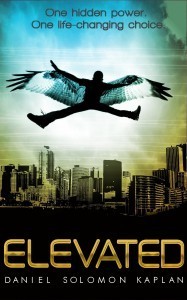 Elevated by Daniel Solomon Kaplan
Elevated by Daniel Solomon Kaplan
Rose doesn’t want to be an Elevated. She refuses to have her power unlocked on Elevation Day, unlike her other classmates. The irreversible treatment reveals powers that range from a benefit or a nuisance. For her father, it transformed him into an Unsound, forcing him to a life of exile.
Her hand is forced after a chance encounter with a previously undiscovered power activates her ability. Living as an Undocumented Elevated, Rose needs the help of others who hide under the government’s radar to learn to control her unwanted power. Among them, she unravels secrets about the treatment, the powers, and what happened to her father. Fed up with lies, Rose wants nothing more than to learn the whole truth–even if it means accepting her fate as an Elevated.
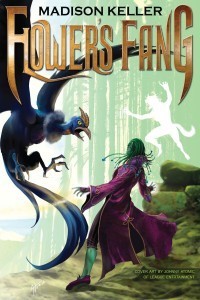 Flower’s Fang by Madison Keller
Flower’s Fang by Madison Keller
In the Kin-Jegera Empire the strength of your magic or your claws determines your destiny – too bad our heroes are short on both!
Prince Se’ls, one of the magical flower Kin and only child of Queen Se’uan, has a terrible secret – he has no magic. Forced by his mother, the Queen, to tour the empire to search for his magical companion, Se’ls is terrified of returning home empty handed.
Arara, long-furred runt and joke of her pack, is dreading the upcoming hunt, where the young Jegera show off their strength by taking down one of the fearsome armored hukra by claw alone. Arara is terrified that her superstitious pack will tear her apart if they learn her secret, that she was born telepathic and telekinetic.
With assassins and dark plots threatening the empire, Prince Se’ls and Arara must band together to save it, or perhaps to destroy it.
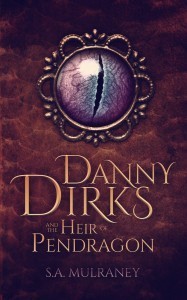 Danny Dirks and the Heir of Pendragon by S.A. Mulraney
Danny Dirks and the Heir of Pendragon by S.A. Mulraney
Danny Dirks wants nothing more than to play baseball in his father’s orchard now that school is out, but he’s finding out that he is no ordinary boy. With the approach of his fifteenth birthday, Danny’s begun hearing voices and seeing visions of his dead mother. He’s also fairly certain that the cute girl next door is really a shape-shifting dragon. All of these things lead Danny to the discovery that he is the heir of the legendary Arthur Pendragon and the linchpin in a pact established between man and dragon centuries ago. Now, rogue dragons threaten that pact and the peace that comes with it. They aim to reopen the portal through which they originally came to Earth in order to bring back a rebel dragon army. It’s up to Danny to learn to channel the power that is Excalibur and, with his new friends, prevent the portal from being opened.
 A Chronetic Memory by Kim O’Hara
A Chronetic Memory by Kim O’Hara
In 2215, the science of chronography allows researchers glimpses of the sights, sounds, and smells of the past, as recorded in chronetic energies. But these promising explorations have become mired in politics and greed. When seven-year-old Jored Wallace goes missing, only one person, chronography intern Danarin Adams, realizes he’s gone. Soon she finds out that Jored’s disappearance is only the first of many timestream disturbances. Who can she trust to help her set things right?
 Little Gou and the Crocodile Princess by Robyn Paterson
Little Gou and the Crocodile Princess by Robyn Paterson
“Every last member of the Mao family will die by the Hour of the Rat a fortnight from now.”
With these words begins a race against time, as the roguish martial artist called Little Gou hunts across the back roads and waterways of Old China to find a young bride-to-be who has become a pawn of the mysterious Lady Moonlight. He must outwit friends and foes alike, all of whom are dancing to the Lady’s song, and unravel a scheme that could see thousands dead or enslaved and the Middle Kingdom aflame with rebellion if he fails. But, worst of all, he has to face the woman who abandoned him in the name of family duty- the love he can never be with, or forget.
Influenced by Legendary Wuxia novel writers Gu Long and Jin Yong; and in the spirit of movies like Crouching Tiger, Hidden Dragon; Little Gou and the Crocodile Princess is a martial arts action & adventure thriller set in the Jianghu martial underworld of Old China. Through a combination of wits, swordplay and kung fu, the martial artist Little Gou, and his companion the warrior nun Sister Cat, must uncover the truth behind a deadly plot to bring the martial underworld to its knees, or die trying.
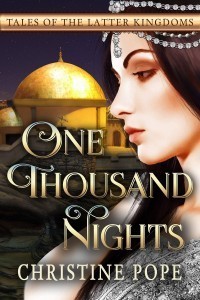 One Thousand Nights by Christine Pope
One Thousand Nights by Christine Pope
Lyarris Deveras, Crown Princess of Sirlende, takes a leap of faith and accepts an offer of marriage from the ruler of the far-off kingdom of Keshiaar, although she knows it means she will never see her family or her homeland again. Betrayed by his first wife, her new husband has vowed never to love again. But with a little luck — and a bit of magical intervention — Lyarris plans to melt her new husband’s stony heart in this novel inspired by the Thousand and One Nights, set in the world of the Latter Kingdoms.
WAR IS COMING
Ten days have passed with no sign of the rebellion.
Alone, Asher waits
as new Knights are made
and festivities are raised.
Hannah’s coronation approaches,
and the Queendom makes ready,
but everyone knows
the Scion is coming.
Book #4 in a series of fantasy novellas.
Beneath the surface of a distant water planet in the last human colony of Civica, fears of an ancient enemy walking among them have brought tension levels to a boiling point.
Captain Jacob Stone wants nothing more than to live a peaceful life aboard his ship, the Rogue Wave, but while on a routine cargo haul, he and his crew discover a dark secret that could unravel the fabric of their society and ignite civil war.
When an act of sabotage kills thousands and throws the colony into chaos, Jake is caught in the middle, and must seek answers in a place no one believes exists. Can he find them before it’s too late?
Exile is the second book in the Novum series and sequel to Novum.
IN THE YEAR 2010, an alien virus nearly wiped out the human race. A thousand years later, mankind has recovered and ventured into space. There has been no sign of the aliens since. Humanity remains confined to the Solar System.
All that is about to change.
Mazzy Webber is a lowly janitor on a third-rate cargo ship. Deeply in debt, when his captain decides to turn pirate, he leaps at the chance.
A modern Robin Hood–minus the part where he gives back to the poor–Webber lays down a few ground rules. No attacking manned ships, and no stealing from anyone who can’t afford it. Within months, he and the crew are out of debt. Their next target will make them rich.
But the attack goes all wrong. The target’s cargo could be the death of them–or it could be the key to reaching the stars.
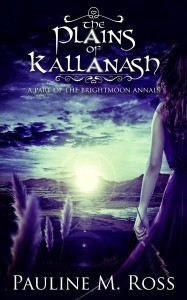 The Plains of Kallanash by Pauline M. Ross
The Plains of Kallanash by Pauline M. Ross
Thousands of years after a magical catastrophe reshaped the world and pulled the moons out of alignment, the secret of magic has seemingly been lost. At the centre of the vast, forbidding Plains of Kallanash lies a land ruled by a secretive religion, whose people fight a never-ending war against the barbarians in the wilderness beyond the border.
Amongst the nobility, double marriages are the norm. Junior wife Mia always dreamed of attracting the attention of the dashing lead husband, but never dared to compete against her lively older sister. Hurst has spent ten frustrating years as junior husband, longing to test his skill with a sword in battle, longing for his beloved Mia to turn to him.
The mysterious death of Mia’s sister thrusts the marriage into turmoil. As Mia and Hurst struggle to adjust and find out what happened, they uncover sinister truths about the ruling religion. But the gods are unforgiving; even Mia’s innocent questions carry a terrible punishment. Hurst is prepared to risk everything to save her, even if it means taking up his sword against the barbarians, his own people, and the gods themselves.
When student Jim Hopkins gets the bus home to Stoke Newington one night, he has an encounter that changes his life – and his views on magic and vampires.
 Robert and Louie by Hollis Shiloh
Robert and Louie by Hollis Shiloh
Hired to redecorate the Skeffield country home, Louie is both attracted to Robert Skeffield and abashed by him in equal measures. Louie, who favors bright clothing and has never been called butch in his life, has little in common with gorgeous, masculine, and closeted army officer Robert. But not everything is as it appears, at Skeffield Manor or in their hearts…
Takes place after “Wes and Kit”
This story contains some minor steampunk elements, magical elements, mysterious elements, flirting, a dog, and a strawberry-colored waistcoat.
Sensual rating: very low
Length: 30,500 words
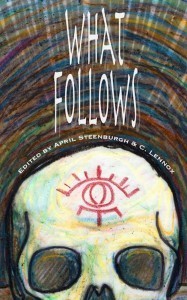 What Follows, edited by April Steenburgh and C. Lennox
What Follows, edited by April Steenburgh and C. Lennox
How would an Immortal deal with the End Times?
The world will inevitably come stumbling into apocalypse, and They will be there to witness it. Dryads, demi-gods, deities of every pantheon- is it possible for the Eternal to handle an ending with grace?
Should it come through disease, disaster, or religious fervor, discover What Follows…
Stories by Lyn Thorne-Alder, M.J. King, Joyce Chng, Kate Larking, Nina Waters, K Orion Fray, E.V. O’Day, Crystal Sarakas, Sarah Lyn Eaton, and Ross Bennett.
Kevin just wants to finish his senior year of college and graduate.
Before he can do that, though, he must finish his summer internship. When his boss’s genetic engineering experiment goes awry, Kevin gets sucked into an adventure he never wanted.
It will change him forever… if it doesn’t kill him first.
Buddy is a 10,000-word story. It contains some violence and adult situations.
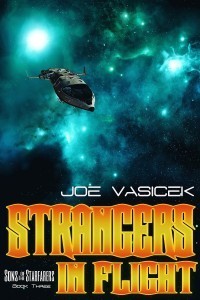 Strangers in Flight by Joe Vasicek
Strangers in Flight by Joe Vasicek
FATE HAS BROUGHT THEM ACROSS TIME AND SPACE, BUT WAR WILL DRIVE THEM FARTHER
For countless ages, Reva Starchild has slept in perfect cryostasis. Frozen in secret to escape a catastrophic death, she awakens only to find herself the sole survivor of a people whom history never remembered. Light-years from her homeworld, among a culture she finds both perverse and obscene, she must somehow build a new life for herself where misplacing her trust could be fatal.
With nowhere safe to run, she finds refuge on a small starship with a mysterious young man who seems to be fleeing something as well. Where others have sought to enslave her, though, he treats her with unexpected kindness. As they slowly open up to each other, she learns that he too carries a burden—one she can barely comprehend.
Isaac Deltana indeed carries a burden. The failure of his mission at Colkhia has brought untold calamity to the Outworld forces and almost certainly led to the death of his brother. Now, he flees from the Gaian Imperials to prevent them from obtaining the secret technology he carries—one that will change the face of interstellar war forever.
Little does he know, the Imperials aren’t the only ones hunting him in
This is book 3 of the Sons of the Starfarers series, following Brothers in Exile and Comrades in Hope.
Claire Jacoby is desperate to remember who she is and where she comes from. Isolated by the fact that she can’t remember her past, she builds a life, however hollow, out of the fragments of herself that remain. In the seven years since awaking alone and confused in the woods, she’s learned to hide behind social customs, creating a facade to protect the secret she hides from the rest of the world.
Claire is struggling with disconcerting flashes of information, unsettling thoughts and images that she fears are memories. When William Foley comes into Claire’s favorite cafe, his very presence demanding her attention, she’s overcome by the sense that she knows him. He sweeps into her bitter, colorless little life, unconcerned about hiding his unnaturally quick movements and cold skin, and starts putting Claire back together piece by piece.
William knows Claire and has the answers to questions she’s been asking for seven years. He also knows she has dangerous enemies. William must protect Claire as she learns more about herself, each piece of the puzzle bringing her ever closer to those who have sworn to see Claire dead.
“A girl deeply wounded, more afraid of life than of death, may just be the best hope for mankind’s survival.”
Remnants of humanity are scattered high in the mountains, far from the deadly disease that wiped out ten billion lives. While everyone claws for survival, Micka cuts lines and numbers into her skin. The day she decides to press the blade deeper, a stranger steps into her life and makes an offer she finds hard to decline.
Warning: This book is not for the faint of heart. Do not buy if you abhor violence, intense language, and non-explicit sex.
 Send to Kindle
Send to Kindle
A new release and a new series: Overdose
I’m afraid you’ll have to wait a bit longer for the Birmingham photos, because today I have a new release to announce, a short mystery called Overdose.
Overdose is the result of another eight hour fiction challenge, which you may remember from previous times I took part. You can read some more about the process of writing the story over at Pegasus Pulp.
And since Overdose features Detective Inspector Helen Shepherd, Police Constable Walker, who even acquires a first name, Kevin, and forensic medical examiner Dr. Rajiv, all of whom you may remember from The Cork and the Bottle, I even seem to have committed a new series, the Helen Shepherd Mysteries. The Cork and the Bottle has also gotten a new branded series cover.
But for now, here is Overdose: When Caroline Murray is found dead in an underground parking garage with a needle in her arm, the case seems clear. Caroline died of a drug overdose.
When Caroline Murray is found dead in an underground parking garage with a needle in her arm, the case seems clear. Caroline died of a drug overdose.
However, everybody who knew Caroline insists that she was vehemently opposed to drugs and would never have taken any. And what was Caroline doing at 544 Grant Road, a building to which she had no known connection?
Detective Inspector Helen Shepherd is quickly convinced that Caroline Murray’s death was not a simple drug overdose. But who had reason to want Caroline dead and why?
For more information, visit the Overdose page.
Buy it for the low price of 0.99 USD, EUR or GBP at Amazon US, Amazon UK, Amazon Germany, Amazon France, Amazon Spain, Amazon Italy, Amazon Canada, Amazon Australia, Amazon Brazil, Amazon Japan, Amazon India, Amazon Mexico, Kobo, Barnes & Noble, Apple iTunes, Scribd, Smashwords, Inktera, txtr, Thalia, Weltbild, Hugendubel, Der Club, Libiro, Nook UK, DriveThruFiction, Casa del Libro, OmniLit/AllRomance e-books, Flipkart, e-Sentral, You Heart Books and XinXii.
 Send to Kindle
Send to Kindle
September 27, 2014
Back from Birmingham, mixed announcements and some brief thoughts on Doctor Who
As the title indicates, I’m back from Birmingham. That is, actually I came back on Wednesday (on a 7 AM flight – ugh), but I’ve been too tired and busy for blogging until now.
There’ll be more observations and photos soon. But for now, here are some announcements:
I have begun uploading my books to Smashwords, following some recent policy changes on their part. I’ve also done one of their self-serve interviews.
If you’ve been interested in trying the e-book subscription service Scribd, you can now get a free 3-month trial via Teleread. Of course, you can also read some of my books while you’re at it.
And now, let’s talk about Doctor Who.
As you may know, I stopped watching Doctor Who regularly sometime towards the end of David Tennant’s tenure, when I realised that the Doctor was no longer a character I liked, let alone wanted to watch. Ever since then, I’ve watched only intermittently, when there’s some kind of landmark episode such as those written by Neil Gaiman or when I find myself within the broadcast range of BBC1 while Doctor Who is on. Every single time, the verdict inevitably is, “This is really shit. Looks like a Colin Baker or Sylvester McCoy episode.” and “Crap, was Doctor Who always this bad?”
When Peter Capaldi took over as the Doctor, I was pretty sure that would be the end of my more than ten year enjoyment of the show, because I had serious issues with Capaldi (outlined here) and disliked the direction the show was taking in general.
However, I once again found myself in the UK, while Doctor Who was on. And so I thought, “Why not watch for old times’ sake? Who knows, maybe it’s better than expected?”
You can imagine how well that one went.
The episode I watched was called Time Heist (I kept calling it “Space Heist” throughout and had to edit the title later, which tells you how much of an impression it left), written by Stephen Thompson and showrunner Steven Moffat and directed by Douglas Mackinnon. Here is a recap from the Guardian as well as Emily Asher-Perrin’s summary/review of the episode at Tor.com and here is Paul Cornell telling us the five things he thought were brilliant about Time Heist, also at Tor.com.
Now Paul Cornell is maybe my favourite new Who scriptwriter alongside the wonderful Rob Shearman who hasn’t been seen since way back in season 1. Nonetheless, I completely disagree with him that the episode was brilliant. Instead, coming back to it as someone who hasn’t watched Doctor Who in a while, it was just bad. What makes this even more of a pity is that I’m normally a sucker for heist and caper stories, so I should have been all over this one. Instead my friend and I watched for fifteen minutes, collectively shook our heads and said, “This is crap. Let’s go for dinner instead.”
Let’s start with the Doctor, number 12 or rather 13, if you include John Hurt’s War Doctor as a legitimate regeneration. Now I had my problems with the choice of Peter Capaldi from the beginning. Not because I don’t think Peter Capaldi is a fine actor – he absolutely is. However, he also is one of those people who make my skin crawl on a gut level. And the fact that I primarily associate him with playing a child-murdering scumbag politician on the Doctor Who spin-off Torchwood doesn’t help.
I’d feared that I’d been too hard on Peter Capaldi – after all, he is a fine actor and it’s hardly his fault that he makes my skin crawl and I can only stand him in villain roles. But rumblings I heard online seemed to suggest that Capaldi’s Doctor was mean to Clara and more Valeyard than Doctor in general. Which is coincidentally what I said back when the announcement was first made: “This man might make an excellent Master or Valeyard, but I can’t really imagine him as the Doctor.”
Upon first seeing the Doctor, my friend exclaimed, “That old dude is supposed to be the Doctor?! But he’s ugly.”
Me: “Well, the Doctor isn’t supposed to be attractive. After all, none of the Doctors were traditionally handsome. Tennant and McGann probably came the closest.”
My friend: “But he’s… really old.”
Me: “Oldest actor to play the role since the First Doctor back in the 1960s. But then Doctors were rarely played by young actors until the new series and besides, he is supposed to be more than a thousand years old.”
My friend: “But he’s… kind of icky.”
Me: “He is, isn’t he?”
Plus, the Doctor proved himself to be an unpleasant person within the first few minutes of the episode, when he walked in on Clara preparing to go out with her boyfriend (Clara has a boyfriend? Must have happened since I last watched). Now date-crashing Doctors are nothing new, just ask long suffering Mickey and Rory. But this Doctor didn’t just crash Clara’s date, he also had words about her appearance. Precisely, he asked her, “Why is their paint on your face?”
Yeah right, because in over a thousand years of life, much of which was spent among humans and particularly in the company of young human women, the Doctor still hasn’t cottoned on to the fact that women sometimes wear make-up. Criticizing Clara’s appearance (especially since my friend and I both agreed she looked great) just made the Doctor come across as a jerk.
Plus, it’s apparently a thing with this Doctor. Cause later that evening, using my daily 30-minute allowance of free WiFi, I saw the following exchange in Twitter:
Like 90% of the gifsets of Capaldi's Doctor I've seen so far involve him criticising Clara's appearance in some way. WHY.
— Foz Meadows (@fozmeadows) September 20, 2014
It makes me want to do a masterpost of every such comment from Moffat's tenure directed at female companions.
— Foz Meadows (@fozmeadows) September 20, 2014
@AthenaHelivoy @fozmeadows No other series of the show that I've seen has seemed so convinced that negging constitutes playful banter.
— Andy H. (@indeed_distract) September 20, 2014
@indeed_distract @AthenaHelivoy God, it fucking is negging, isn't it? That is EXACTLY what it is.
— Foz Meadows (@fozmeadows) September 20, 2014
Yeah, I know what you’re thinking. That’s just Moffat. After all, Steve Moffat’s problem with writing female characters is well known and it only seems to have increased over the years. At any rate, back in the days of Coupling, Moffat was as harsh on the men as on the women. And it’s sad that old Doctor Who delivered more interesting and diverse female characters back in the 1960s and 1970s than new Doctor Who in the 2000s. And it’s not just Moffat who’s to blame for that one, Russell T. Davies is as much as fault. Never mind that Davies can only write a single convincing female character, namely “Rose” in all her guises (and “Rose” shows up throughout Davies’ work).
But even though he is an alien and occasionally behaves that way, the Doctor is still the character who is supposed to have our sympathies. And a Doctor who continuously mistreats his companion is a hard character to like, as the Sixth Doctor (and to a certain degree Seventh Doctor) found out to his detriment. Now all new Who Doctors have behaved abominably towards their companions, just see Eccleston’s and Tennant’s treatment of Jack, Mickey and Martha as well as one episode companion Adam. But since Peter Capaldi is not very likable to begin with (unlike the generally likable Tennant and sort of likable Eccleston), the bad treatment of Clara is even more notable.
Luckily, we didn’t get much time to get outraged about the Doctor mistreating Clara and crashing her date with a cute black guy (at least, Doctor Who continues to be as pleasantly diverse and full of interracial relationships as it was in the days of Russell T. Davies), because the TARDIS phone rang and then the Doctor and Clara were suddenly somewhere else with two new characters called Psi and Saibra and were informed that they had agreed to a mindwipe and were supposed to rob a bank in a heist planned and instigated by someone called the Architect.
Then our cool quartet were off to the bank, which unfortunately turned out to have a rather unique security system, an alien monster called “the Teller”, which has the ability to detect if someone has guilty thoughts or intentions. Luckily for the Doctor and his companions, the Teller has homed in one another bank customer who is harbouring guilty thoughts (and did the “guilty” customer really have to be a black man?), which is just as well, because it turns out that the Teller’s brain scans kill the victim. Holding the Teller’s leash is Keely Hawes in a rare turn as a villainess.
The idea behind this episode actually isn’t bad at all, plus I’m a sucker for heist and caper stories. Plus, the Teller is a good monster, Psi, Saibra and Clara are likable characters and Keely Hawes makes a good villainess. So what went wrong? Why was the actual episode so bad that we both agreed to switch off after fifteen minutes and go for dinner instead?
First of all, Time Heist looked cheap and I mean really cheap. Now looking cheap is something of a tradition for Doctor Who, dating back from the original series with its bubblewrap and tinfoil monsters. But while the new series had the occasional really cheap looking episode (The Long Game, Boom Town, Fear Her, etc…), it generally looks pretty good or at least manages to mask the cheapness. However, of late most episodes I’ve actually watched, e.g. last season’s Nightmare in Silver, looked really, really cheap. Okay, so maybe there have been budget cuts at the BBC, but why not cut back on the number of episodes per season instead of sacrificing the overall quality?
I’ve already talked about the fact that the Doctor is an unpleasant character, which is probably down more to Moffat’s writing than Capaldi’s acting. However, this episode suffered from another side-effect of Moffat’s writing, namely his preference for non-linear timey-winey wibbly-wobbly plots.
Now Doctor Who is hardly the only place where Moffat uses timey-winey wibbly-wobbly plots. Non-linear plots pop up in Coupling, generally to great effect, e.g. the episode The Girl with the Two Breasts. They also pop up in Sherlock. And since Doctor Who is a show about time travel, it lends itself to non-linear plots. However, by now Moffat is so in love with his timey-winey wibbly-wobbly non-linear plots that he doesn’t just use them once or twice per season, but every single episode. Which makes for some very confusing viewing.
Under Russell T. Davies, Doctor Who was occasionally experimental, occasionally straight forward and occasionally silly, but it was rarely confusing. Even if you only watched a single episode or watched the episodes out of order, you could generally get what was going on. Under Moffat, however, Doctor Who is increasingly confusing. Watching just the occasional episode here and there is no longer possible, because much of the time you will have no idea what is going on. And even individual episodes are confusing because of the predominance of non-linear plots. Of course, everything will probably become clear by the end of the episode (I hope). But first you need to get there. And yes, I know that arc plots and binge watching are a thing. But Doctor Who has never really been the sort of arc heavy, binge watching show, unlike e.g. Lost or Game of Thrones.
Indeed, I find myself wondering whether new Doctor Who was ever really good or whether we were simply so desperate for any sort of Doctor Who at all that we were willing to overlook its faults. And let’s not forget that when new Doctor Who came along in 2005, the SFnal airwaves were ruled by the Stargates and the grimdark, Ron D. Moore slaughtered new Battlestar Galactica. Lighter and outright fun SFF was hard to find and SFF in general was the province of some not very good shows on the SciFi Channel in the US. Star Trek had just ridden off into the sunset, seemingly for good. Lost had only just started up. Britain had zero SFF shows at all at the time. Since then we’ve had Supernatural, Game of Thrones, True Blood, Sleepy Hollow, The Walking Dead, Arrow, Agents of S.H.I.E.L.D., Outlander, Penny Dreadful, Orphan Black, True Detective, etc… in the US and Life on Mars, Ashes to Ashes, Being Human, Misfits, Torchwood, Outcasts, Jekyll, etc… in the UK. Of course, not all of those shows fulfilled their promise, some fell down after a couple of seasons and others never were my cup of tea at all. However, there is no denying that televised SFF is so much better now than it was back in 2005 and that there is so much more of it than there was back then.
Doctor Who was a breath of fresh air at the time, a show that was not afraid to be fun and even cheesy on occasion and still managed to effect you emotionally. Now it’s just another SFF show and not even a very good one at that.
 Send to Kindle
Send to Kindle
September 18, 2014
In Birmingham
I’ve arrived safely in Birmingham and am now utilizing my 30 minutes of free hotel WiFi per day.
We continue to post all sorts of great content over there, so check it out to tide you over until I get back.
 Send to Kindle
Send to Kindle
September 17, 2014
Away for a few days
I’ll be in Birmingham in the UK for a few days with only spotty internet access, so blogging and tweeting and other internet activities will be only sporadic.
But have no fear, there’ll be photos when I get back.
 Send to Kindle
Send to Kindle
Realism and Revolutions in Science Fiction
The weak worldbuilding of many modern dystopias is a well known problem. It’s particularly endemic among YA dystopias (which are mostly metaphorical rather than realistic anyway), but dystopian fiction aimed at adults isn’t immune as e.g. the 2002 movie Equilibrium with its flat-out unrealistic finale (“Yeah right, like it would be so easy”, I thought upon first viewing) shows. By the way, I had completely forgotten that William Fichtner whose performance as the disabled cop Carl Hickman in Crossing Lines is a large part of what makes that show worthwhile, was also Equilibrium. But then a lot of unlikely people were in Equilibrium, including a bunch of German TV actors, which makes watching the film an even weirder experience than it would normally be.
Now I’ve always had a soft spot for what I call “revolution SF”, science fiction about a brave ragtag band of rebels fighting some kind of oppressive system. These stories used to be quite common, both in space opera, before it got colonised by military SF and the representatives of the system suddenly became the heroes, and in dystopian SF proper. The main difference was that in space opera the revolution usually succeeded, whereas in dystopian SF the system usually won and our brave ragtag band of rebels either managed to escape into the wilderness, if it was a happy ending dystopia, or were broken, reabsorbed into the system and/or killed, if it was a really bloody depressing dystopia. I preferred the happy endings, of course, though I gobbled up all of them as a teenager, happy and sad. I was never happier than when I was made to read both Brave New World and 1984 in 12th grade, because hey, we were reading science fiction in school and even the “good kind” (i.e. revolution SF). Okay, so both books ended unhappily, as did the short fiction they made us read such as E.M. Foster’s The Machine Stops. But then it was school, so expecting SF about revolutions that actually succeeded would’ve been too much to ask.
At around the same time I was devouring SF about brave bands of rebels fighting against unjust systems and winning at least some of the time, there were plenty of people standing up against corrupt or unjust systems in the real world. And occasionally, they were even winning. In the Philippines, dictator Ferdinand Marcos was kicked out of office in 1986. In Haiti, another dictator Jean-Claude “Baby Doc” Duvalier was kicked out of office also in 1986. In 1987, the June Democracy Movement succeeded in pushing for a democratic presidential election in South Korea. Okay, so the establishment candidate won, because the two opposition leaders split the vote, but at least it was a start. Meanwhile, in the Soviet Union Mikhail Gorbachev took office in 1985, gradually introduced domestic reforms from 1986 and more extensive reforms from 1988 on, which led to the domino-like toppling of the Communist regimes in Eastern Europe over the course of the year 1989, culminating in the fall of the Berlin Wall on November 9, 1989. In early 1990 finally, Nelson Mandela was released from prison and apartheid in South Africa began to crumble. And with a few exceptions, all of those revolutions managed to succeed with very little bloodshed.
If you were a teenager during those years and watched all of those events unfold on TV, you might be forgiven for believing that the world was getting steadily more free and much better in general. Of course, there were setbacks, e.g. the student protests in China which culminated in the Tienanmen massacre, but those would only be temporary. After all, China had a population of one billion people even back then and no regime could possibly suppress that many people forever. Sure, the 1968 revolts (still very present in the popular consciousness, especially the the veterans of 1968 were our teachers) might have largely failed, but we were better than they had been and this time things would work out. After all, things were already working out all over the world, as people who had been oppressed for decades were finally standing up. And once we – meaning the entire world population here – had managed to get rid of the really nasty and oppressive dictatorships, we’d take on the conservative old people who were ruling much of the western world, the Ronald Reagans and Margaret Thatchers and Helmut Kohls and Francois Mitterands, and give them the boot as well and install a system that allowed for popular referendums (I was very fervently in favour of referendums as a teen) while we were at it. And then we’d all live happily ever after.
Only that it didn’t quite work out that way. West German politicians across all parties promptly decided we should unite with East Germany without even asking either of us first (probably because they feared the answer in the West might be no) and without replacing our flawed postwar constitution either. Meanwhile, the East Germans were so blinded by consumerism that they voted Helmut Kohl (who would never have been reelected if not for the unification) into office for a third term (and eventually a fourth). The liberation of Eastern Europe mostly led to mass unemployment. In what was still known as Yugoslavia back then, the Balkan Wars were heating up. And within a few years, it also turned out that East Germany was (and sadly continues to be) infested by xenphobes, racists and outright Neo-Nazis.
Growing up in the climate of general revolution and liberalisation of the late 1980s, while being taught by teachers who still couldn’t shut up about how great 1968 had been, it was obvious why I would want to read and write about revolutions in my chosen genre SF. By the mid 1990s, when the revolutions of the 1980s had stagnated or flickered out, the political system in the now united Germany seemed unable to ever change, when homes for asylum seekers in East Germany as well as the entire Balkan was burning, it was equally understandable that I decided that stories about science fictional revolutions were all fine and dandy, but that no one over the age of approx. twenty-five could ever taken them seriously, because we all knew how revolutions went in the real world.
Seen from this POV, it’s not just obvious why teenagers go for stories about the lone teen rebel in dystopia toppling an oppressive system and probably finding true love while he or more frequently she is at it (and if The Hunger Games, Divergent et al had been around, when I was 15, I’d have been all over them, too), but also why many adults find it difficult to take them seriously. Because we know that the world just doesn’t work that way. And it is notable that neither The Hunger Games nor Divergent have a truly happy ending. Tris dies and while Katniss manages find some personal happiness, the new system that replaces the old one doesn’t turn out to be necessarily better.
Regarding SFnal revolutions done right, my favourite example is a rather unlikely one, namely Simon R. Green’s Deathstalker saga, a series that looks like lighthearted “everything and the kitchen sink” space opera on the surface and yet has unexpected depths. The set-up is well known: A brave band of rebels fights and eventually overthrows an authoritarian regime headed by an evil galactic empress. In short, it’s exactly the sort of story that is narrative catnip for me. And yet Green does something you rarely see in stories like this. First of all, his rebellion is made up of multiple fractions, all with their own goals, and usually squabbling among each other. A lot (most in fact) of the characters also join the rebellion not for ideological reasons, but because they have nowhere else to go, because the rebellion promises loot and business opportunities, because it’s cool to be subversive, because it will piss off their families, because the rebellion means lots of bloodshed and violence or because the rebels have the best drugs.
The Deathstalker series is also quite unusual, since it doesn’t stop with the overthrowing of the evil empress, but shows what happens afterwards. The people who build up the new system (which is a constitutional monarchy modelled after the United Kingdom, which is rather amusing in itself, because these people fight a bloody rebellion to become the UK of all places) are not those who actually fought to bring down the old, but instead career politicians and military men who remained loyal (with some internal doubts) to the old system until the bitter end and then quickly change their tune (in post-unification Germany, we called such folks “Wendehälse”), while the actual rebel fighters find themselves unable to fit into the new world. Very few of them, mostly supporting characters, have a happy ending, while the main characters mostly die and/or wind up alone and broken. Not exactly what you’d expect from something that looked like a fun space opera romp at the beginning.
As for myself, I stopped writing revolution stories for almost twenty years, though I still loved to read them, because I knew that any “And then they all lived happily ever after” ending would be a lie, since the real world just doesn’t work that way. Never mind that I was largely paralyzed by all sorts of second hand ideas of how SF should be, even though I neither liked what was held up as good SF nor wanted to write it. Eventually, I said, “To hell with all that! I’ll write my space opera the way I want.” And the way I wanted my space opera was with a lot more emphasis on character and society and less of a tech focus than usual. Coincidentally, focussing on the individual characters also offered the answer to my problem with fictional revolutions. For while the new system is not necessarily better and not everybody lives happily ever after, individual characters can get a happy ending for themselves within such a framework.
I agree with Esther Inglis-Arkell that world history is a great source not just for fictional revolutions, but for any sort of SFF in general. And you shouldn’t just focus on the usual suspects either and write the umpteenth retelling of the fall of the Roman Empire in space or the Napoleonic Wars in space. Talking of which, did you ever notice that hardly any of those Napoleonic Wars in space retellings are ever preceded by the French Revolution in space? Even though the French Revolution was a necessary precondition for Napoleon’s rise to power.
As for fictional revolutions, I think writers should look beyond the French, Russian and American revolutions, when there are so many other revolutions and liberation movements in history, both failed and successful, that you can stripmine for ideas.
The history of the Fifth Human Empire from my Shattered Empire series borrows quite liberally from West German postwar history (History Lesson is the one to read). The reasons are that I was pretty familiar with West German postwar history already, yet it’s obscure enough to the world at large that the sources aren’t immediately obvious. Plus, there are so many incidents and events that I really couldn’t have made up any better. Finally, it also gives me the chance to rewrite history a bit and get an outcome I like a bit better than the real version.
Because there is one other truth about revolution SF. Stories about science fictional revolutions whether in space or against some earth-bound dystopia grow from dissatisfaction with or outright anger at an existing system. And so the fictional dystopia or evil galactic empire is often a highly distorted version of whatever country the author hails from. The original Star Wars trilogy is so obviously fueled by disillusionment with the US post Vietnam War and Watergate that I’m surprised these aspects are not pointed out more often. The evil Empress of Simon Green’s Deathstalker series is obviously a Margaret Thatcher stand-in, as are the evil leaders of dozens of dystopias by British authors written from the mid 1980s on. Sometimes you get evil Tony Blair as well, which is at least refreshing. The dim-witted and overweight galactic Emperor who is not actively evil, but surrounded and manipulated by villainous advisers, from the now defunct Femla series I created as a teenager in the late 1980s is obviously a stand-in for German chancellor Helmut Kohl, even though I was totally unaware of it at the time. Meanwhile, the current YA dystopias are reactions to mass surveillance, the war on terror, the war on women as well as reality TV and the celebrity cult.
It’s been said before that science fiction is about the present, even if it is supposedly set in the future. And so it’s only logical that our dystopias and evil galactic empires would reflect the concerns of our present.
 Send to Kindle
Send to Kindle
September 14, 2014
Two new Shattered Empire stories available: Seedlings and Debts to Pay
Today I’ve got a double release in the Shattered Empire series to announce, because both the long awaited novella Debts to Pay as well as a new Shattered Empire short story named Seedlings have just come out.
Seedlings is another story focussing on Holly di Marco and Ethan Lord Summerton, whom we first met in Mercy Mission and History Lesson. It was originally intended as the opening scene of an upcoming novella, but somehow it didn’t really fit in with the rest of the novella. However, the characterisation and worldbuilding would have been a pity to lose, so I finally decided to turn it into a standalone short story.
Debts to Pay, which features Holly’s friend and fellow mercenary Carlotta Valdez on a solo mission, had an even more complicated history, because it is an extensive rewrite of a short story called “The Nighthuntress” that I wrote more then twenty years ago during my second semester of university. When I looked through my inventory of finished stories, I also came upon “The Nighthuntress”. The writing needed a lot of work and besides the story tied in to the now defunct Femla universe, a space opera universe I developed in my teens and that’s basically unusable now, though parts of it survive in the Shattered Empire series.
As I read “The Nighthuntress” again for the first time in twenty years, I thought, “Some of this is actually quite good.” I also realised that it would work quite well as a solo mission for Carlotta Valdez. So I rewrote the entire story from scratch and also added in some elements, e.g. the Smoofs don’t exist in the original story at all.
I’m quite happy with the result, plus we learn a lot more about Carlotta, including the identity of her mystery lover who is mentioned in History Lesson. And can I just say how happy I am about the cover art, especially since it’s so difficult finding SF stock art featuring women who don’t look like strippers or sex workers as well as any kind of stock art featuring people of colour at all.
Seedlings Once Ethan Summerton was the heir to a lordship, and a whole planet besides. But all that was taken from him, when his father decided to side with the Galactic Rebellion against the Fifth Human Empire and was murdered for his troubles along with the entire Summerton family, leaving Ethan the only survivor.
Once Ethan Summerton was the heir to a lordship, and a whole planet besides. But all that was taken from him, when his father decided to side with the Galactic Rebellion against the Fifth Human Empire and was murdered for his troubles along with the entire Summerton family, leaving Ethan the only survivor.
Now, cooped up with more than two thousand other Rebels in the eternal night of the planet Pyrs, Ethan Summerton is reduced to tending the rebel base’s greenhouse. Not that he minds – Ethan has never been a snob and besides, he’s always liked gardening. Besides, it gives him the chance to impress his new best friend Holly with the crops he’s growing.
A hardened mercenary, Holly di Marco doesn’t have much use for gardens and greenhouses and strange leafy things. But they matter to Ethan and since Holly is supposed to take care of him, she tries to feign interest as well.
But then one day, an incident involving a lost little girl, chickens and batavia lettuce shows her what Ethan Summerton is truly made of.
For more information, visit the Seedlings page.
Buy it for the low price of 0.99 USD, EUR or GBP at Amazon US, Amazon UK, Amazon Germany, Amazon France, Amazon Spain, Amazon Italy, Amazon Canada, Amazon Australia, Amazon Brazil, Amazon Japan, Amazon India, Amazon Mexico, Kobo, Barnes & Noble, Apple iTunes, Casa del Libro, Scribd, Inktera, txtr, Thalia, Weltbild, Hugendubel, Der Club, Libiro, Nook UK, DriveThruFiction, OmniLit/AllRomance e-books, Flipkart, e-Sentral, You Heart Books and XinXii.
Debts to Pay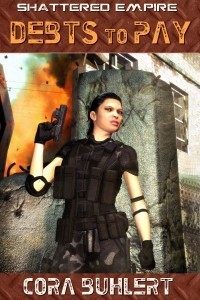 Once Carlotta Valdez was a mercenary, working for the highest bidder. No job was too dirty or too dangerous as long as she got paid.
Once Carlotta Valdez was a mercenary, working for the highest bidder. No job was too dirty or too dangerous as long as she got paid.
But then Carlotta had a change of heart. She joined the Rebellion against the Galactic Empire and met rebel leader Arthur Madden, perhaps the only man in the universe she genuinely admires.
However, the past has a nasty habit of catching up with you when you least expect it. And so, while on a mission for the Rebellion, Carlotta runs into Darius Gilroy, crime lord, all around scumball and her former boss. Gilroy had a job for Carlotta and he won’t take no for an answer. And to emphasise his point, he threatens to hand her over to the Empire, if she doesn’t accept.
So Carlotta finds herself en route to the rimworld of Rothea III to take out a drug lord who has been encroaching on Gilroy’s territory. The drug lord certainly won’t be missed, but how can Carlotta reconcile an assassination job with her newfound rebel convictions? And how can she get Gilroy off her back, lest he threaten her and her comrades again?
For more information, visit the Debts to Pay page.
Buy it for the low price of 3.99 USD, EUR or GBP at Amazon US, Amazon UK, Amazon Germany, Amazon France, Amazon Spain, Amazon Italy, Amazon Canada, Amazon Australia, Amazon Brazil, Amazon Japan, Amazon India, Amazon Mexico, Kobo, Barnes & Noble, Apple iTunes, Casa del Libro, Scribd, Inktera, txtr, Thalia, Weltbild, Hugendubel, Der Club, Libiro, Nook UK, DriveThruFiction, OmniLit/AllRomance e-books, Flipkart, e-Sentral, You Heart Books and XinXii.
Finally, I also want to mention that you can buy a bundle of all Shattered Empire stories at DriveThruFiction for only 5.99 USD.
 Send to Kindle
Send to Kindle
September 13, 2014
Harvest Festival 2014
This Saturday was not just the start of school for this year’s crop of first graders, but also the day of the harvest festival, an annual celebration of farming and food that consists of a parade through my semi-rural suburb of Bremen, a service at the local Lutheran church and a big party in the evening and night (held on the football field some 500 meters from my home and therefore rather noisy).
Since the parade passed through my street, I had the chance to take some photos. Photos of the 2011 and 2012 harvest festivals may be found here, by the way. I must have missed the 2013 festival for some reason.
This year’s harvest parade seemed a little shorter and had fewer floats than those in previous years with longterm stalwarts such as the choir Liederkreis Harmonie, the homeowners’ association Siedlervereinigung Hördener Heideweg and the local chapter of the Kyffhäuserbund (originally a war veterans’ organisation, now a social club for the rural elderly) missing. I suspect that the Kyffhäuser and Liederkreis Harmonie simply died out, given the advanced age of their membership. Come to think of it, the same might apply to Siedlervereinigung Hördener Heideweg, since the original homeowners of Hördener Heideweg must be in their 70s by now.
Nonetheless, I’m glad that we still have a harvest festival parade, since a lot of these small festivals have died out in recent years.
Now let’s have some photos:
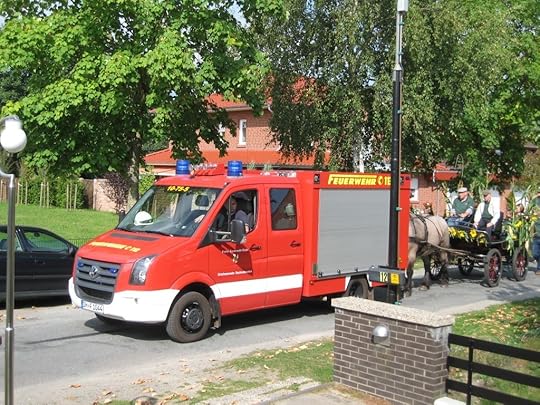
As every year, the parade is headed by a fire truck of the local volunteer fire brigade.

Directly after the fire truck came this festively decorated horse-drawn carriage. The horse seemed rather impatient with the speed of the parade and constantly kept pushing against the back of the fire truck, as if trying to make it go faster.
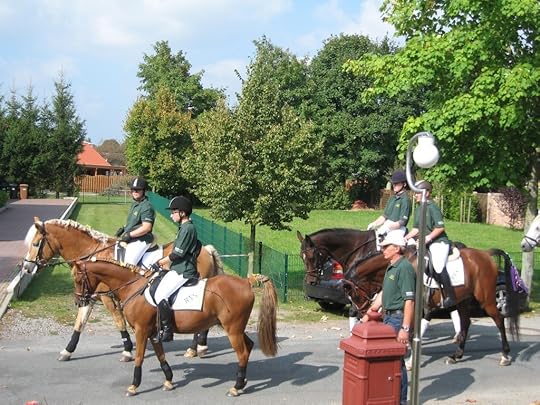
Young members of the local riding club join the parade.

The float bearing the harvest crown is the traditional centerpiece of the parade. Local clubs and organisations take turns making the harvest crown and organising the festival. This year, the women’s gymnastics team made the crown. After the festival, the harvest crown is displayed in the local church.

The float of this girls’ basketball team is decorated with corn cobs.

“Hest em bi di?” (“Have you got it with you?” in Low German) is a bowling club with a twist: All members carry around a small plastic pig. If two members happen to meet on the street, one will ask the other, “Have you got it with you?”, whereupon the other member must produce the plastic pig or pay a fine. The pig also figures prominently in the decoration of the club’s float which celebrates Germany’s World Cup win.

Plush pigs decorate the rear of the “Hest em bi di?” float.
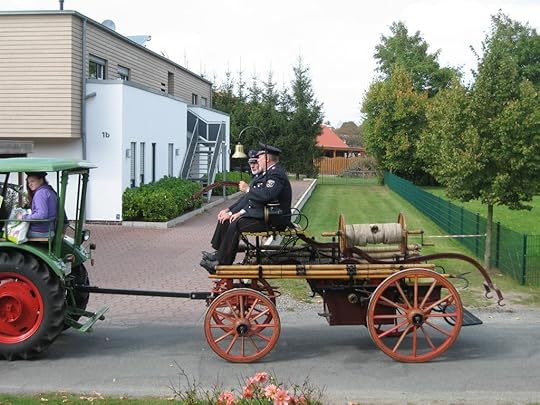
Two gentlemen of the local volunteer fire brigade ride this vintage fire pump.

The volunteer fire brigade’s main float is decorated with a fire hose and flashing blue lights.

The Bavarian themed float of the Landjugend (Country youth) delighted the entire parade with techno music in the mistaken assumption they were attending the Love Parade. I also think they were having a barbecue on their float.

This beautifully decorated float belongs to “Alle Neune” (All nine), another bowling team. Note the tiny gilded bowling pins dangling from the arches.

This rather basic float belongs to a men’s football team.

The float of this club for players of the card game Skat is decorated with garlands of playing cards.

I have no idea which club this is, but their float sure is pretty.

A very big tractor is pulling the float of a boys football team.

A group of pirates decided to join this year’s harvest festival parade.

Three pirates decide to use a lull in the parade to relieve their bladders onto an empty lot.

Giant sunflowers decorate the float of this girls’ handball team.
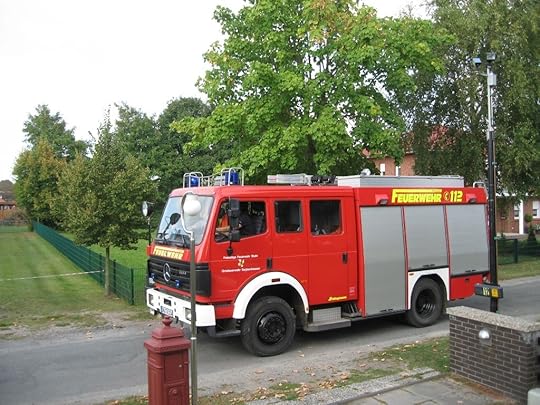
A second fire engine brings up the rear.
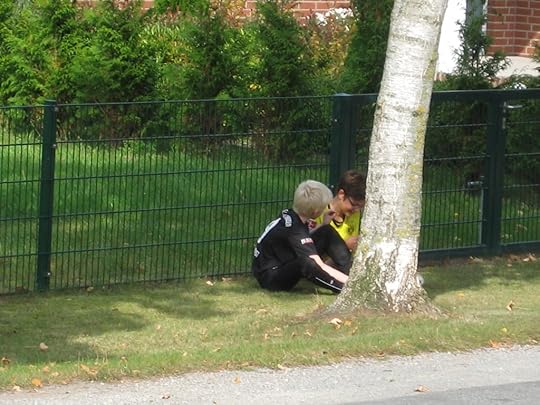
After the parade has passed, these two little boys have settled down in a quiet spot behind a tree trunk to inspect their loot, candy thrown from the parade floats to the spectators.
 Send to Kindle
Send to Kindle
September 11, 2014
Photos: Lüneburger Heide 2014 (with bonus crazy house)
Here in Northwest Germany, one of the most popular destinations for holidays and short trips is the Lüneburger Heide, a nature preserve with a unique heath landscape that’s great for hiking, biking and horseback riding. It’s particularly beautiful in late summer and early autumn when the heath is in bloom, turning whole swathes of the landscape pink.
I already posted some photos of the Lüneburg heath in 2012, but those photos were taken when the heather bloom was almost over, so the heath looks brown rather than pink. This year, we went to visit the Lüneburger Heide earlier in the year, so I managed to catch the heath in full bloom.
The Lüneburg heath is actually divided into two nature parks, the Lüneburger Heide proper and the Südheide (Southern heath). We initially drove to the Lüneburger Heide nature park where the 2012 photos were taken, only to find every single parking lot literally overrun by tourists (for some reason they were also wearing the most garish parkas imaginable). They’ve also installed parking ticket machines in the meantime. So we said, “Screw all that!” and decided to try the Südheide instead. Cause I’ve been to Südheide before and found it just as pretty as the Lüneburger Heide nature park and a lot quieter.
We finally ended up in an area called Heide am Schillohsberg between the villages of Hermannsburg and Unterlüß. The Heide am Schillohsberg was not just quieter than the massively travelled area between Over- and Niederhaverbeck, we literally didn’t see another human being there. The area was also wilder and a bit less manicured than the Over-/Niederhaverbeck area.
So let’s have some photos:

Step into the heath. The path leading to the Heide am Schillohsberg is so narrow you can barely see it from the road.

Heide path with the branches of an oak tree.

Here the heather plants are intermingled with young pine trees.

The heath is dotted with juniper bushes. At the edge, you can see a woodland area with pine trees.

Heath with juniper bushes

A hunter’s seat overlooks the heath.

A path across the heath, bordered by pine trees.

A heather plant grows in the middle of the path. Note the sandy ground, a relic of the Saalian ice age, which made the Lüneburg heath possible.

An information display showing a crosssection of soil from the area. The Lüneburg heath is the result of sandy deposits left behind the the retreating glaciers of the Saalian ice age.

Heide path viewed through the low hanging branches of pine trees.

Heather growing at the edge of a pine tree forest.

Heath panorama

Heath dotted with juniper bushes and birch trees.

A dead birch tree towering above the heath

Heath path with overhanging branches

Heath in bloom

A fork in the road.

A close-up look at a heather plant

Heather is not the only plant in the heath. Here is a blackberry bramble.

This bush grows little red berries.
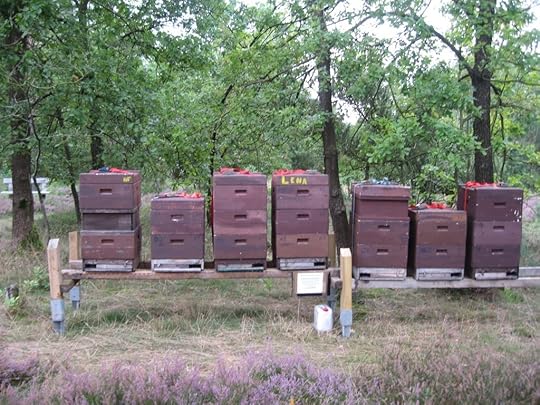
Beehives. Beekeeping is common in the Lüneburger Heide, cause Heide honey has a unique taste and is much sought after.

More Heide fauna. These horse droppings have attracted a dung beetle (half hidden underneath the blades of grass).
The unique landscape is the main attraction of the Lüneburger Heide. However, the area also contains a myriad of flashier tourist attractions appealing to younger children and their parents. What is more, the Lüneburger Heide may seem remote and secluded, but it actually lies smack dab in the centre of the Hannover-Hamburg-Bremen triangle with a combined population of almost three million people. That’s a lot of potential candidates for a day trip or a weekend break. As a result, the Lüneburger Heide area contains no less than seven theme parks to serve the people of Hamburg, Hannover and Bremen. They’re popular destinations for school trips and I think I’ve visited all of them at one point.
There are also plenty of smaller tourist attractions and several of them are clustered around the highway A7 at the exit Bispingen halfway between Hamburg and Hannover. There is a go-cart racing track, an archery range (archery has become popular of late with kids emulating Katniss, Hawkeye, Green Arrow or Merida from Brave), a couple of fastfood franchises and two rather strange structures.

When you cross the highway bridge at Bispingen, you suddenly see this rising from the morning mist. At first, I thought it was a particularly expansive highway bridge, but it’s really an indoor skiing arena.
Here is the official website, in English even.

This structure, called the Crazy House, is an upside down house. Note Spider-man climbing along the side of the crazy house, probably wondering which villain is to blame for this.

Another look at the crazy house. The staircase at the lower lefthand corner allows visitors to access the house.
The official website of the Bispingen Crazy House shows that the entire interior including furnishings is upside down as well, allowing for lots of bizarre photo ops. Though not bizarre enough for the 5 EUR ticket price IMO.
Apparently, there is a whole Crazy House franchise with three crazy houses all over Germany.
And how do you get a house to stand upside down anyway? This video explains all.
 Send to Kindle
Send to Kindle
September 6, 2014
And still more Hugo and WorldCon Analysis
It’s been three weeks now, since the 2014 Hugos were awarded at LonCon3 and yet we’re still talking about both.
At the Los Angeles Review of Books, Martin Petto offers a recap of LonCon3 and the Hugo Awards, including the whole Sad Puppies and Wheel of Time debacle. He’s not very happy with many of the winners in the fiction categories, largely because they don’t match his definition of what progressive speculative fiction should look like. It also seems he really dislikes emotional content in SFF (sadly a big problem in the community). I also disagree with his “leftwing British versus rightwing American SFF” dichotomy, because in my experience it’s not so simple, though American SFF is more likely to lean right. But then, I’ve always bounced hard of what he calls the “British boom” anyway, while SFF books by British writers I’ve loved inevitably weren’t considered part of the boom.
At Obsidian Wings, Doctor Science offers a very good analysis of the Hugo results with a particular focus on the sad puppies slate championed by Larry Correia and friends.
His (I’m assuming Doctor Science is male) observations about the sad puppy nominees largely match my own. Because IMO the sad puppy fiction nominees were all weak stories, not just Vox Day’s entry. Retro-pulpy 1930s stuff like Larry Correia’s should be right up my alley, but this one wasn’t. I kind of liked one of Brad Torgersen’s previous stories (Ray of Light) plus I know he has a fanbase beyond the sad puppies, so I thought that at least one of his two nominees might turn out to be decent. Alas, no such luck and the editing issues make me wonder about Analog, a magazine which has published good work in the not too distant past. As for the The Butcher of Khardov by Dan Wells, Doctor Science rightly likens it to “a description of an unfamiliar videogame” and indeed the novella apparently was some kind of gaming tie-in. However, I have zero knowledge of or interest in the game in question, so I couldn’t get into the story at all.
And indeed this is why I explicitly did not nominate e.g. installments in long-running series that make little sense without having read the rest of the series in question for the Hugos, no matter how good some of them might have been. Coincidentally, this also applies to Correia’s novel, which was the third part of a series.
Doctor Science also wonders whether the Sad Puppies suffer from some kind of cognitive dissonance and genuinely believe that the works they nominated have literary merit.
This post from Brad Torgersen’s blog certainly seems to support this assertion. He repeats the already familiar accusation that many Hugo voters care more about demographic labels than about literary quality and then accuses Hugo voters of being “anti-success” since highly successful writers like Kevin J. Anderson or Tad Williams or Dave Farland a.k.a Wolverton or L.E. Modesitt have never won nor been nominated.
Now Hugo voters certainly aren’t anti-success, considering that the list of recent Hugo winners and nominees includes such massively successful authors like Neil Gaiman, J.K. Rowling, George R.R. Martin, Susannah Clarke, etc… However, the vast majority of Hugo voters and nominators rightly believes that a Hugo nomination should require some sort of literary merit, however defined, beyond “I enjoyed this” and “This sold a shit ton of copies”.
Now taste is subjective. For example, Brad Torgersen actually likes Baen covers, which I thought no one except Jim Baen ever liked, even if they enjoyed the actual books (luckily my own copies of Poul Anderson’s Dominic Flandry novels, courtesy of Baen, don’t look nearly so horrible as the current covers). Hence, it’s entirely possible that there are people out there who genuinely believe that Opera Vita Aeterna and Warbound and The Butcher of Khardov and The Exchange Officers were among the best works of speculative fiction published last year. The people who nominated Wheel of Time probably also thought it truly was amongst the best works of SFF ever. And indeed there are some Hugo shortlist regulars whose appeal makes me scratch my head, because I have no idea why they are so popular. This year, there were two non-Sad Puppy/non-Wheel of Time nominees on the Hugo shortlist whose popularity is truly baffling to me, because I consider them very poor writers. There really is no accounting for taste.
However, there also seems to be a certain contingent of people, mostly in the US, who are actively hostile to the idea that there is such a thing as artistic merit and who believe that financial success is the main or only arbiter of literary quality. It made a lot of money, hence it must be good. Which is of course crap, because we all know that artistic merit and financial success are not necessarily mutually exclusive, but rarely go hand in hand. Otherwise, Stephenie Meyer would have won the Hugo for Twilight (which I actually would have liked to see, if only for exploding heads), E.L. James and Dan Brown would win the Nobel Prize for Literature and Transformers – Whatever the latest installment was called would win the Oscar for Best Film.
Meanwhile, here is a wonderful Twitter rant by John Scalzi, multiple Hugo nominee and winner, about why thinking solely in sales numbers is useless, because publishing is not a zero sum game. Even sad puppy in chief Larry Correia seems to have grasped this, because he regularly promotes books by fellow authors to his fanbase.
The cognitivie dissonance on the sad puppy side of the spectrum also seems to extend to being unable to grasp that if they don’t like something, it doesn’t automatically follow that no one else will enjoy that thing either. Cause judging by recent complaints that those evil leftwingers want to suck all fun out of speculative fiction some of them certainly seem to believe that. Uhm, no. Actually we love SFF as well. However, in the past our enjoyment of SFF was frequently tarnished by the gross racism and sexism in the genre, by the erasure of whole swathes of people and their experiences, by the rampant militarism, the clunky prose or characters who seem as if they were written by sentient AIs who had never met a human being before. Now, however, the SFF genre has become much bigger and includes more works that those who’ve frequently felt excluded from mainstream SFF can enjoy unreservedly. Which is a good thing for everyone. And those who like SF novels about squarejawed white American military dudes doing stuff in space, fear not. Such books are still being published. Baen Books is doing fine and the SFF categories at Amazon are full of indie books about squarejawed white dudes doing stuff in space.
Meanwhile, Gavia Baker-Whitelaw’s Daily Dot post about the generation gap she noticed at WorldCon, which I linked to in my last Hugo/WorldCon post round-up, has attracted quite a bit of controversy, since her WorldCon experience does not match that of many other attendants.
Singaporean writer J.Y. Yang attended both Nine Worlds and WorldCon and points out that the whole old versus young dichotomy is a bit reductive and that both cons felt rather white to her. It’s a great post, which was pointed out to me by two separate people.
At Practically Marzipan, Aishyarya Subramanian offers not only a detailed write-up of both Nine Worlds and WorldCon, but also a comparison of both, and comes to the conclusion that both had their strengths and weaknesses. Found via Everything is Nice.
Liz Bourke, nominee for the best fanwriter Hugo, also offers a recap and comparison of WorldCon and Nine Worlds and wonders whether the generation gap reported by some wasn’t due to the fact that WorldCon was larger overall. She also notes that the attendants at Nine Worlds seemed more affluent to her (or maybe just more fashion conscious) than those at WorldCon.
At the Speculative Fiction Showcase (which I’ll stop plugging soon, honest), Jessica Rydill offers her WorldCon recap and points out that she didn’t really experience the domination of old white men described by Gavia Baker-Whitelaw and others.
Fran Wilde and Gail Carriger both offer a detailed recap of WorldCon (and in Gail Carriger’s case Nine Worlds) with lots of pictures.
At Amazing Stories, Jane Frank has a two part WorldCon recap with a particular focus on the visual art on display.
 Send to Kindle
Send to Kindle
Cora Buhlert's Blog
- Cora Buhlert's profile
- 14 followers



